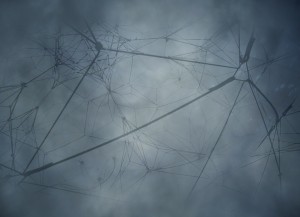Digital Logics _ T3
Case study Blur Building_Yveron Les Bains
Text Rhizome_ Thousand Plateaus by Gilles Deleuze and Félix Guattari
The Blur Building is a pavilion for Swiss EXPO 2002 at the base of Lake Neuchatel in Yverdon-les-Bains, in Switzerland. From a distance, this indistinct structure resembles a cloud of mist and pumped air, emerging dynamically over a lake. But can it be defined as an architectural result? The answer depends on the way you perceive architecture. The meaning of this atmospheric concept cannot be captured unless you consider it as a living experience in space and time. The interaction with its environment is much more intense than in a regular structure. Inside it you lose the sense of dimension and gravity. Shape is formed according to the movements of humans inside a huge cloud of fog created by molecules of water. This experimental space is adjusting to the weather conditions constantly, through a smart system that translates weather data in pumping pressure and as a result density of fog. Water is the primary element. It constitutes the constructive material of every boundary formed inside this structure. It is an attempt to redefine the boundaries between human and nature, while at the same time, realigning social relationships.
The concept is that inside this experimental amorphous space, dominated by mist, visual and acoustic ability are lost. As well as the sense of space and time. Entering from a stair that emerges through fog, humans have to concentrate and rely on their senses in order to be guided around the building. The interaction between the users is accomplished according to an intelligent system. Visitors are required to fill a questionnaire just before they enter the project. According to it, they wear coats with sensors that prove the degree of attraction and repulsion between them, by using emissions of different colors, visible through the fog.
Regarding digital logics, associativity between part to whole is evident, as through this structure you experience yourself in relation to the other visitors. You establish your presence and position through the presence of others. Transformation sequences is also observed as the amount of fog is changing constantly, adapting to both the environment and the visitors. The pressure of water in the nozzles depends on different parameters such as climate conditions and human interaction, creating in this way algorithmic relations. There is also structural correspondence to both the weather conditions and the visitors, as well as the transference of data in and out of the structure using sensors to capture climate changes and sensors for visitors’ interaction.
This deeply philosophical text, written by Gilles Deleuze and Félix Guattari, introduces rhizome, as a concept that allows studying different notions perceiving them as multiples, individual parts connected to an undifferentiated whole with no beginning nor end, editable and mutable every single moment. The whole is related to the individual parts. In case one condition changes different results are produced, creating different versions of the same whole. A rhizome reacts constantly to its environment, adjusting to it.
Five main principles emerge through this text. Multiplicity claiming that multiple should be perceived as a substantive, treated as an undifferentiated whole and not as a unity of many different particles. Points and positions are not visible in this way of analyzing a structure. Only lines are countable and attached to the sense of dimension. It refers to the flattening of all the multiplicities on a single plane, regardless of their quantities. The necessity of connection and heterogeneity of every single point to the rest of the points, is another main principle pointed out. A rhizome differs from roots simulation or a typical tree branching as it is not possible to find any kind of origins in it. It is not a closed system. It is an ever-changing unit. You can identify it and perceive its possible different versions only by observing the behavior of its different particles or through different dimensions. Another important principle indicated through this text is that of asignifying rupture. Contrary to the signifying shapes separating a structure creating in this way a definite cutting section of the whole, when a rhizome is broken it redefines its boundaries forming new rhizomes, new multiples. When a rhizome is raptured the old lines from which it is consisted of, create new ones, still connected to each other, forming new rhizomes. Thus, a rhizome cannot be destroyed. However the result of the division of the parts cannot be always defined accurately. The last principles mentioned in the text are those of cartography and decalcomania, indicating that a rhizome cannot be analyzed using axes, or an organized structure. The processes of mapping and tracing are essential in order to comprehend the notion of rhizome. What distinguishes mapping from tracing is that they do not associate in the same way with reality. A map constructs a subconscious image, open to further processing, able to receive new data and connect to different dimensions. It has multiple entries, in comparison to the procedure of tracing that focuses to a specific element, related to reality, returning always to its essential point.
Both case studies signify the importance of the role of the different particles that constitute a whole unity in its final shape or condition. Both of them also depend on multiple parameters that change constantly the shape or form of the whole. They also have the ability to receive new data and adjust to the circumstances occurring each time.
As a further research line, according to the case study and text mentioned above, I would like to explore further, how different parameters and the entering of new data taken by the environment, influence the shape and form of an interactive structure, always perceived as a concept of continuous alterations rather than a static building.

